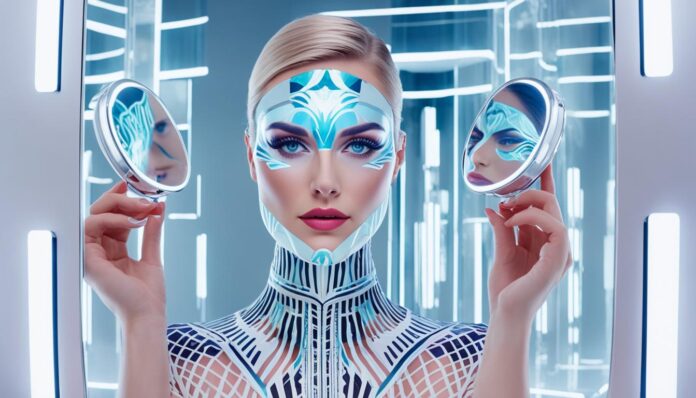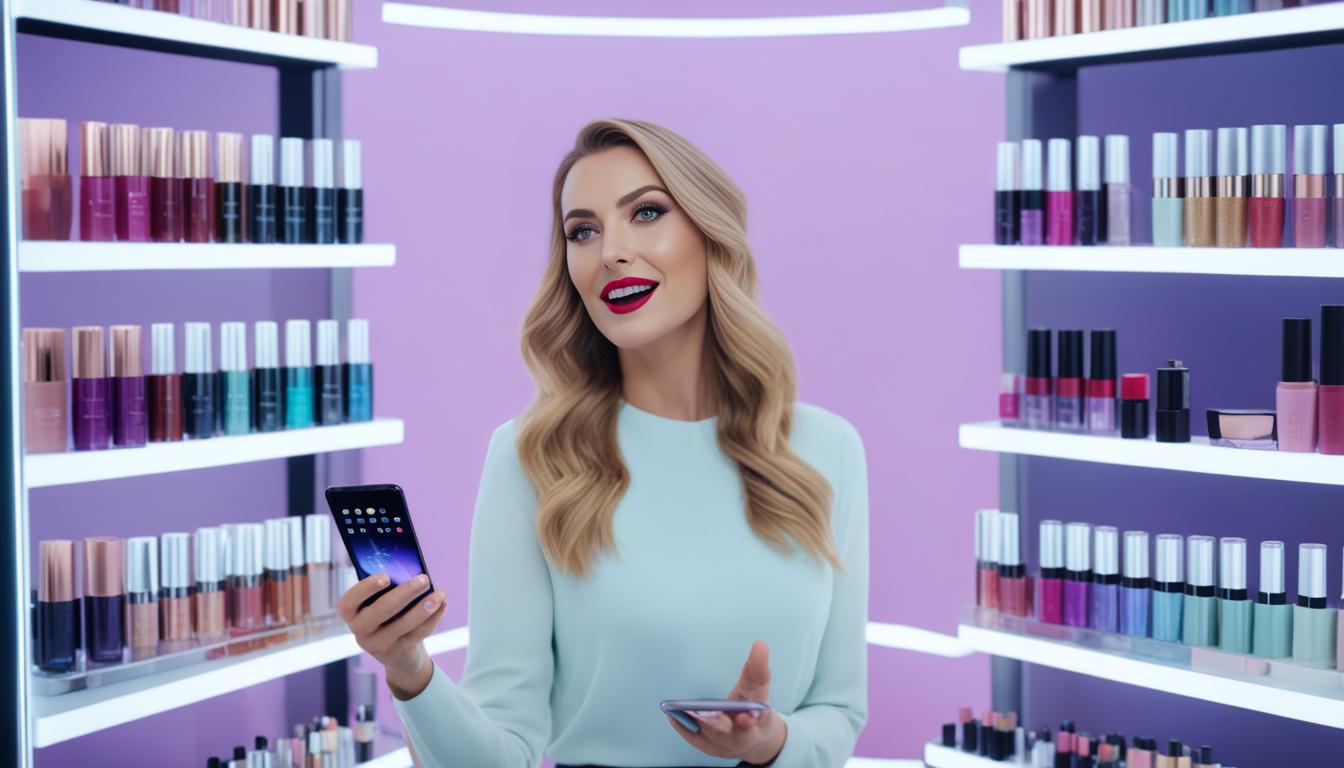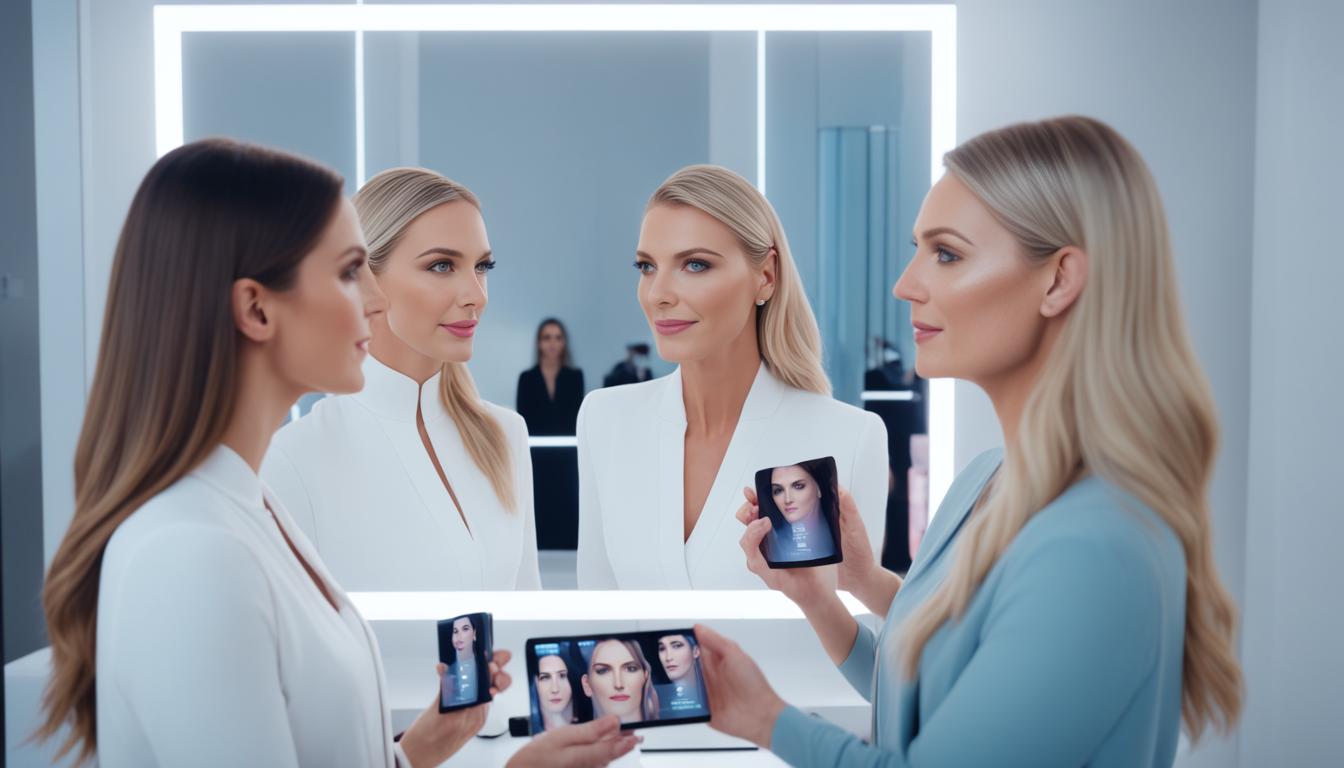
Did you know the beauty industry is growing fast with VR and AR? It’s expected to grow by 25.5% each year from 2022 to 2027. This shows how big a deal augmented reality beauty is for both brands and us as consumers. Now, with AR makeup apps, we can try on makeup looks on our phones before buying them. This tech helps us see how different products will look on us, making shopping easier.
AR is changing how we think about beauty and make choices. It’s making our shopping more confident and changing our beauty routines. Let’s see how this tech is making a big impact on the beauty world.
Key Takeaways
- The AR beauty market is expected to grow at a CAGR of 25.5% from 2022 to 2027.
- AR enables us to visualize makeup looks on our skin tones, improving shopping confidence.
- Augmented reality tools can reduce product return rates and increase profit margins for brands.
- AR technology simplifies the color comparison process, saving us time and effort while shopping.
- Utilizing AR in beauty allows for hyper-personalized experiences tailored to individual needs.
Understanding Augmented Reality and Its Impact on Beauty
Augmented reality (AR) changes how we interact with beauty. It adds digital content to the real world, making beauty products more engaging. This mix of real and virtual creates interactive beauty experiences that change how we shop and use cosmetics.
AR technology in beauty has many uses. It lets us try on makeup virtually, avoiding the mess of traditional methods. We can get personalized advice from virtual beauty experts, finding makeup and skincare that fits our unique needs.
AR doesn’t just help online shopping. It also changes in-store experiences with interactive displays and live demos. This is key in a beauty market worth over $500 billion, as shown by Statista in 2023.
Looking ahead, AR technology is getting even better. Companies like L’Oreal are investing in AI to make virtual try-ons more personal and connect with us on social media. This new approach helps us connect with beauty products in a unique way, boosting engagement and sales.
AR campaigns like Nyx’s “Haunted Dollhouse” show its power. They draw in consumers and keep their attention, making products more appealing through virtual experiences.
While AR has its challenges, like color accuracy and texture realism, we see big potential. Augmented reality is set to change the cosmetics industry. It offers new ways to improve user experiences and marketing.
| AR Application | Description | Impact on Consumers |
|---|---|---|
| Virtual Makeup Try-On | Try on makeup virtually without physical application | Encourages experimentation without commitment |
| Virtual Beauty Advisors | Personalized recommendations for skincare and makeup | Enhances consumer confidence in product choices |
| Interactive In-Store Displays | AR mirrors allow real-time makeup application previews | Bridges online and offline shopping experiences |
| Social Media Filters | Custom AR filters for brand promotion on platforms | Increases brand visibility and engagement |
Augmented Reality Beauty: A New Era in Cosmetics
Augmented Reality beauty is changing the game in cosmetics. It lets us try on makeup and test nail polishes virtually. No mess, no hassle. AR technology makes this possible in our daily lives.
Beauty apps and filters are changing how we shop for makeup. Snapchat, with over 800 million users, offers a platform for brands to engage with us. PulpoAR’s tech lets us virtually try on nail polish and makeup. This fun experience helps us feel confident in our choices.
AR filters are making a big difference. They help us buy products we’re sure to love. In fact, using AR filters makes us more likely to buy something.
AI technology is making our beauty routines more personal. It gives us product recommendations based on our skin type. Big brands like L’Oreal use AI for better personalization.
Tarte Cosmetics saw a 200% increase in sales with a virtual try-on feature. This shows how AR can boost sales.
The beauty industry is growing fast, with a value of about $528.6 billion in 2022. AR has led to more customer engagement and loyalty. It’s also made beauty brands worth 32% more.
But, we need to think about privacy and data as AR beauty grows. The future looks bright, with more exciting things to come.
The Rise of AR Makeup Apps
The beauty industry is changing fast, and AR makeup apps are leading the way. These apps let us try out makeup without the need for real products. Big names like L’Oréal and Burberry are jumping on board, giving us super-realistic experiences with virtual try-ons.
L’Oréal’s Makeup Genius app is a great example of this trend. It started in 2014 and lets users try on makeup in real time. It makes trying out different products easy and suggests ones that fit our skin and style. The app also has tutorials to help us learn new makeup looks.

Sharing our virtual makeovers on social media gets more people involved. The Makeup Genius app takes our shopping to the next level by letting us scan products in stores. This adds an interactive layer to our shopping trips.
Using AR makeup apps has made people more engaged with brands. This means we’re trying out more products and finding styles that really speak to us. It’s all about exploring and finding what makes us unique.
| Feature | Benefit |
|---|---|
| Real-time virtual makeovers | Allows users to experiment with different looks instantaneously |
| Personalized recommendations | Enhances product relevance based on individual preferences |
| Interactive tutorials | Facilitates skills development in applying makeup effectively |
| Social media sharing | Encourages community engagement and user-driven promotion |
| Barcode scanning in-store | Bridges the gap between physical and digital shopping experiences |
AR makeup apps show how the beauty industry is embracing new tech. As these tools get better, we’ll get a shopping experience that’s more personal and meets our digital needs.
Exploring Virtual Cosmetics
The beauty world has changed a lot with digital tools, especially virtual cosmetics. Now, we can try on different makeup products like foundations, lipsticks, and eyeshadows. These tools let us customize our makeup and find the best look for our face shape.
With personalized visualizations, our makeup journey gets better. They look at our skin tone and face shape to give us advice. This makes picking makeup easier and more fun. We can try out different looks without feeling pressured to buy them right away.
Even though virtual try-on tech isn’t perfect, it’s really useful. You can’t feel makeup on your skin, but seeing how it looks is a big plus. It opens up new ways to explore beauty.
Virtual beauty events and personalized skincare advice are just the start. These tools are breaking down barriers, making beauty more inclusive and fun for everyone.
As makeup shopping moves forward, virtual cosmetics will keep getting better. With ongoing tech improvements, these tools will make exploring beauty more fun and tailored to us.
AI Beauty Filters: Enhancing Our Digital Experience
AI beauty filters have changed how we use technology and see ourselves online. They use advanced augmented reality to give us instant makeovers. This lets us try out different looks easily. With over 900 million downloads worldwide, these tools have really caught on.
Big names like Estée Lauder and MAC Cosmetics have added AI beauty filters to their marketing. For example, Estée Lauder saw a 2.5 times increase in sales with its Lip Virtual Try-On feature. e.l.f Cosmetics also saw a 200% jump in sales with their virtual try-on tech.
Young people, especially Gen Z in Europe, really want personalized beauty advice. A big 68.3% of them want skincare products that fit their skin type. These AI tools make social media more fun, with over 600 million interactions on beauty filters. They also change how people buy things.
No7’s personalized shade matching system is a great example of AI in beauty. It uses real-time skin tones against a huge database of shades. This makes shopping more sustainable and helps reduce waste. As AI and AR beauty tech grows, it’s making shopping better for everyone.
Using AI beauty filters is changing how we do our makeup. More people are using digital tools every day. This shows how AI is shaping what we think is beautiful and affecting our shopping choices.
Digital Makeup Try-On: How It Works
The beauty industry is changing with digital makeup try-on technologies. These tools use augmented reality (AR) to let customers see how makeup will look on them. This makes shopping online easier and more fun.
Real-Time Applications for a Flawless Look
Companies are using AR to create realistic digital makeup try-ons. Studies show that 70% of people are more likely to buy a product after trying it on virtually. L’Oréal’s Makeup Genius app, with over 20 million downloads, shows how popular this trend is.
Comparing Classic and Modern Methods
People are moving away from traditional testers. AR tools offer a new way to try makeup. A survey by Ulta Beauty found that 71% of customers would buy more makeup if they could try it online first.
This makes shopping more fun and leads to fewer returns. Brands using virtual try-ons see 64% fewer returns. The virtual makeup market is expected to grow to $1.3 billion by 2026, showing its importance.
| Factor | Traditional Methods | Digital Makeup Try-On |
|---|---|---|
| Consumer Engagement | Limited interaction with testers | Enhanced experience through AR |
| Purchase Likelihood | Varies based on in-store experience | 70% more likely after virtual trials |
| Return Rates | Higher due to mismatch | 64% fewer returns |
| Customer Preferences | Testers and samples | Desire for personalized virtual trials |
| Sales Growth | No significant impact | 33% increase reported by brands |
Smart Beauty Mirrors: Future of In-Store Experience
Smart beauty mirrors are changing how we shop for beauty products. They let us try on makeup virtually in stores, avoiding the mess of traditional samples. Sephora and Adidas are at the forefront, offering mirrors that make shopping smooth and connect us to beauty solutions easily.
The smart mirror market jumped from $2.82 billion in 2022 to $3.28 billion in a year. It’s expected to grow, aiming for $5.58 billion in four years. This shows how much we want technology in retail, especially AR solutions that make shopping fun and interactive.
At H&M, 86% of customers used QR codes after selfies with smart mirrors. Wella Professionals’ Smart Mirror connects to over 50 health and beauty services. With most shoppers preferring online shopping, the need for better in-store experiences is clear.
AR technology in smart mirrors makes trying on products easy and helps stores save money. It creates fun experiences that can lead to more sales. Studies show customers who use smart mirrors buy more, proving their value in retail.
Smart beauty mirrors offer a clean and engaging way to shop. They mix the best of physical and digital shopping, fitting what most consumers want. This mix promises a big change in beauty retail, leading to more exciting and tailored shopping experiences.
Augmented Reality Makeup Tutorials: Learning Made Easy
AR makeup tutorials are changing how we learn beauty techniques. They make complex makeup easy to follow, step by step. This lets us practice in real time and learn without fear of mistakes.
Personalized Guidance for Individual Needs
AR apps use advanced tech to give us advice that fits our faces and likes. This makes learning makeup fun and effective. Brands like L’Oréal and Sephora use AR to offer tutorials that fit our unique needs.
Embracing Creativity with Augmented Reality Tools
AR makeup tutorials let us try out new looks before we apply them. We can play with colors and techniques to be more creative. Perfect Corp offers platforms that inspire us and boost our confidence in makeup.
| AR Makeup Features | Benefits |
|---|---|
| Real-time application feedback | Helps refine techniques and improve skills |
| Personalized product recommendations | Ensures suitable choices tailored to individual needs |
| Creative exploration | Encourages experimentation and boosts confidence |
| Cost-effective learning | Saves time and money by minimizing product waste |
| Enhanced customer engagement | Provides an interactive learning environment |
AI-Powered Beauty Advisors: What They Can Do for Us
AI beauty advisors are changing the game in the beauty world. They offer solutions that fit our unique needs by looking at lots of data. For instance, L’Oréal’s Beauty Genius uses over 6,000 images and 10,000 products to give us personalized advice.
Thanks to advanced algorithms, finding the right beauty products is easier than ever. AI helps us make smart choices, making shopping simpler and connecting us better with brands. L’Oréal has been at the forefront of innovation, showcasing its tech at big events like the Consumer Electronics Show.
L’Oréal has also brought us cool tech like Brow Magic, which lets us try on different eyebrow looks. Since the Makeup Genius app came out in 2014, AI has made virtual makeup a reality. This shows how AI has grown in the beauty world.
For a smooth digital beauty experience, L’Oréal teamed up with Microsoft Teams for the Maybelline Beauty App. This partnership makes virtual makeup during video calls better. With AI, exploring beauty becomes easy and personalized for each of us.

Virtual Makeup Artists: A Personalized Touch
Virtual makeup artists have changed how we see beauty. They use advanced tech like facial recognition and augmented reality (AR). This lets us try out looks in a new way. We get makeup advice that fits our unique needs for any event.
Virtual try-on tech has big benefits. It makes brands more known by 21.3% and sales go up by 300%. We can see how it changes shopping by letting us try products on our faces first. This also makes us spend more time on websites, checking out more items.
AI tools for skin assessment are key in finding beauty. They make us spend more time on websites by 2 minutes and 34 seconds. This leads to a 5x increase in wanting to buy something. Brands like Beauty by Holition use AI to make customers loyal and help retailers grow.
The FaceSDK technology makes makeup look real and lifelike. We can use virtual makeup on different devices easily. This makes getting beauty advice easy and convenient. Customized features in virtual try-ons make us more engaged and help sell more products.
Conclusion
Looking ahead, AR in beauty is changing how we care for ourselves. It brings new ways to interact with beauty products. Now, virtual try-on apps let us try makeup looks without leaving home.
AR isn’t just for fun; it’s changing how we shop and play with makeup. Brands like Esteé Lauder and Ulta Beauty are leading with interactive experiences. This means we can try out makeup looks easily, without the usual in-store limits.
As AR technology gets better, we’ll feel more confident when shopping. This reduces the chance of making a wrong choice and makes us happier with our purchases.
We’re stepping into a future where beauty is more dynamic and fun. As the beauty market grows, AR will be key for companies to stay ahead. Let’s embrace this new beauty tech era. It’s where our unique needs are met with precision and creativity, leading to a deeper beauty experience.
FAQ
What is Augmented Reality Beauty?
Augmented Reality Beauty uses tech to help us try on makeup looks on our phones. It makes shopping easier by showing us how products will look on our skin. This way, we can shop with more confidence.
How have AR makeup apps evolved post-COVID-19?
After COVID-19, AR makeup apps got even better. They let us connect more with beauty products. The growth rate of AR in cosmetics shows how big the demand for personalized shopping is.
What are the benefits of using virtual cosmetics?
Virtual cosmetics let us try on full makeup looks digitally. We can play with different styles and intensities. This helps us find what we like best and makes shopping fun.
How do AI beauty filters enhance my experience?
AI beauty filters work with AR to change hair color, cuts, and makeup instantly. They make our online experiences better, especially on social media. We can try out new looks right away.
What role do smart beauty mirrors play in shopping?
Smart beauty mirrors change how we shop in stores with AR tech. For example, Sephora’s mirrors let us try on makeup virtually. This gives us instant feedback and makes shopping more fun.
How do AI-powered beauty advisors benefit consumers?
AI beauty advisors look at our skin and preferences to suggest products. They use smart algorithms to guide us through many options. This helps us find the best products for our skin.
What can I expect from virtual makeup artists?
Virtual makeup artists use tech to give us personalized beauty advice. They offer tutorials and help us find new styles for any event. This makes us more creative and confident in our beauty choices.
How is Augmented Reality transforming the beauty industry?
AR is changing the beauty world with new, interactive ways to shop. It lets us try on makeup virtually and get advice from AI. This is changing how we shop for beauty products and our beauty routines.
